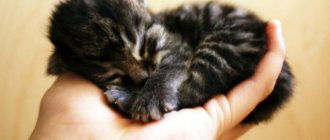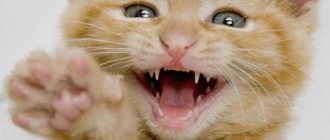It happens that a new pet suddenly appears in the family. - a fluffy little ball that children picked up on the street and persuaded to keep in the house. Often, the owners of a selected animal find it difficult to determine its age and gender, and such knowledge is extremely important for the full development of the kitten, choosing the right diet and instilling social skills.
How to determine the age of a kitten? Many are sure that only a specialist can do this, which means the new pet needs to be taken to a veterinarian. A trip to the veterinary clinic will not be superfluous: the doctor will conduct a full examination of the animal and assess its condition, help determine it, give detailed recommendations for care and feeding, and prescribe the necessary vaccinations.
But you can determine the age of your pet yourself; it is enough to know what signs are used to determine the approximate time of birth of an individual.
Why is it important to know the kitten's age?
Experienced breeders and veterinarians can tell a kitten's age without having exact dates. The process of socialization in kittens begins around two weeks of age and continues until almost two months. It is at this time that you can understand how playful or reserved the kitten is, and how it will get along with people. If the animal has a wild or aggressive character, most likely this will not change in the future.
Foundlings
Kittens of any age are adorable, no matter what breed they belong to. However, it is very important to know when they were born in order to provide them with the correct care and care. As a rule, five signs are enough to independently determine the age of a kitten:
- body size and proportions;
- color and shape of eyes and ears;
- pet's weight;
- number and condition of teeth;
- behavior and activity.
Option three, available to every owner.
If the foundling came to you at an indefinitely early age, and you find it difficult to determine its age by its teeth, then you should wait until the young lady is drawn to “bunches” and, starting from this time, calculate the age of the kitten.
In cats, depending on the breed and constitution, puberty occurs at 6-10 months. That's when the first howls begin. Of course, you won’t breed your bright-eyed beauty in her first heat, but you can guess her age.
Around the same time, a young cat (8-10) begins to mark, so if you are not a fierce opponent of castration, then it is advisable to deprive the cat of the opportunity to spray cat scent as early as possible.
Fully domestic kittens will grow and mature no earlier than a year, and especially large specimens (breeds) of kittens grow until the age of 16-18 months, then the time for paternity and motherhood will come.
Street cats begin sexual activity much earlier, age earlier, lose teeth earlier, die earlier...
How to determine how many days or months a furry pet is: useful tips
It doesn’t matter whether your new pet is purebred or a foundling without a family or breed - there are many ways to determine the age of a kitten that do not require a special approach or veterinary education, just an attentive and caring attitude.
If the kitten is still very young, and is no more than three days old, it still has an umbilical cord, which usually falls off in the first few days. The cat gnaws the umbilical cord and licks the kitten, thereby massaging it and calming it. It is not advisable to pick up kittens before they are two weeks old.
Kittens with mom
You can roughly guess the age of a kitten based on the proportions of its body. A three-week-old kitten has a large head, short legs and small ears. Their coordination of movements at this time is poor, and they spend a lot of time trying to gain control of their paws and body. By one month they become slightly more proportional, and after another month the body becomes longer. By three to four months, their ears lengthen, the kittens become restless and active. Starting from four months, the kitten begins to lose its cute childish features and roundness, and stretches out, even if it gains weight normally.
Kitten development by week
| Age (weeks) | External manifestations | Weight, g | Teeth |
| up to 3 days | There is an umbilical cord, eyes and ears are closed tightly. | 115 | No. |
| 7-10 days | The eyes open. | 200 | |
| 2-3 | Ears rise, eyes are completely open. | 280 | Small but sharp anterior ones emerge. |
| 4 | The baby becomes playful and explores the environment | 370 | Long fangs appear next to the front ones. |
| 5 | Stands steady on his feet | 450 | Milk teeth appear behind the fangs and on the sides of the jaw. |
| 6 | High traffic activity. | up to 700 | |
| 8 | The cat eats and washes itself. | Up to 900 | All baby teeth have appeared. |
| 12-16 | Normal weight for an adult of the breed. | Molar incisors appear. | |
| 4-6 months | The distant molars and canines are erupting. | ||
| 7 months | The indigenous ones have completely cut through everything. |
We suggest you read: What vaccinations are given to kittens of different breeds?
Is it possible to find out the age of a kitten at home?
It’s one thing if a kitten is given as a gift or found, and you yourself become its mother, feeding it from a bottle. It’s a different matter when babies grow up with their mother, and you have the honor of witnessing this touching process. One fine day, your cat, who has often been away from home, suddenly returns with a new addition in her teeth: a tiny ball of hair, or more often than not, several. In addition to being a joy, this can cause some confusion, especially if you are not great at raising kittens. One of the questions that arises is: when exactly were they born, and how to find out? Observation and examination of babies can clarify the situation.
A cat usually begins to wean her kittens off her milk when they are a month and a half old.
This is easy to notice: she will increasingly leave them and leave when the kittens attach themselves to her nipples. However, there are cats that do not stop feeding for up to three months. There are also cats who do not feed their kittens from the moment of birth.
How to feed a newborn kitten if the mother cat refuses to do so
Kittens appeared in your house
Kittens up to two weeks of age move little; they usually sleep almost all the time and drink milk, and occasionally crawl on their stomachs. When they are two to three weeks old, they begin to walk more confidently. By three weeks, they develop an interest in moving objects, they begin to play with rustling pieces of paper and roll small things across the floor. At the age of about a month, they learn to deftly turn over in the air and fall on their paws.
Video - Kittens learn to walk
Closer to two months of life, kittens begin to increasingly explore the world around them, become mobile and increasingly leave their mother, causing her to worry. They often climb a tree, although at first they do not know how to descend, and at this time you need to carefully monitor their movements, because sometimes furry pets overestimate their strength and can get seriously injured if they fall. This is the most restless period for a cat, because you have to watch the children all the time. If the kitten runs confidently and quickly, it is more than five weeks old. It is at this time that a healthy kitten, receiving normal nutrition and care, begins to gain confidence in their abilities because coordination improves, they begin to explore the house, communicate with people and animals, and can make friends with the dog if it is peaceful. At this time, the mother cat vigilantly monitors the dog’s behavior and fearlessly attacks at the slightest threat to the children. Kittens love to play with toys, throwing them and catching them, scratching with their claws and chasing them. Who else can wake you up with the rustling sound of little paws on the floor and make you smile with tenderness?
Little friends
Determining age by behavior
How strange: spoiled children, especially strangers, usually cause us irritation; at best, we do our best to restrain ourselves, trying to be tolerant. But looking at the raging kittens, ready to destroy the whole house in their noisy games, a stupid, touching smile stretches even the faces of stern people.
Kitten games are always a delight
One day, an indignant neighbor rang the author’s doorbell, haunted by the constant roar coming from above. Having crossed the threshold, the man looked for several minutes at the three-month-old kittens, selflessly chasing an empty plastic bottle around the floor, then thoughtfully asked: “How much does it cost?” - and went for the money.
Determining the age of a kitten by its behavior is much more pleasant than looking into the mouth of a small predator and counting its teeth.
Learning to walk
Babies take their first hesitant steps towards the end of the second week of life. At first, it is difficult for them to maintain balance; they sway funny even when sitting, and when they rise to their feet, they have difficulty supporting their plump body on them. Gradually, the forays from the nest become more and more distant, and finally, the bravest one completes the inspection of the entire house.
Between two weeks and a month, babies learn not only to walk, but also to run, jump and climb vertical surfaces using their claws. Having fallen from a height (for example, from a sofa), the baby no longer plops down on the floor with his whole body, but gracefully lands on his paws, deftly turning around in the air.
Month-old kittens run around the house like mad, often knocking over objects in their path.
Hunting is the most important skill for a kitten
By two months, children gradually master hunting skills, their movements and games become more and more “adult”.
From three to six months, the childhood age of small cats is revealed only by excessive activity and immoderate curiosity. By the way, it is during this period that animals often get into trouble, sometimes ending in tragedy.
The author had to endure several terrible hours when his four-month-old cat, having inexplicably slipped through the opened door, decided to explore the new territory and fell into the open hatch of the garbage chute, flying nine floors. Fortunately, the landing was successful: the janitor heard a plaintive meow, and the prodigal daughter was returned to her family.
Learning to eat
As mentioned, WCF strongly recommends that kittens not be separated from their mother until they are three months old. All this time, babies continue to receive mother's milk, but starting from eight weeks, this process is more an element of family communication than nutrition.
They say that kittens need to start switching to solid food at about a month of age, but the author has never had to do this: babies are remarkably “transferred” to adult food on their own when one of them first wanders into the kitchen in search of their mother and discovers her in front of a fragrantly smelling plate.
A month-old fidget will find a bowl of “adult” food on its own
One way or another, kittens begin to feed on their own (lapping and grabbing pieces of food with their teeth) from the ninth week. By this time, as we remember, they have already formed a full row of baby teeth. So, if your baby is pointlessly poking at his plate, he is most likely not yet eight weeks old.
As soon as the kitten begins to receive other food in addition to mother's milk, it is time to accustom it to the tray. Breastfed babies are licked by the cat herself, so they do not need the toilet.
In conclusion, it is worth noting that the speed at which kittens acquire all the above skills largely depends on whether there is an object to imitate nearby. The WCF requirements about the need for kittens to stay in a “full family” for a sufficiently long time are dictated precisely by the fact that for the correct formation of a cat’s character, receiving full maternal education is very important. A puppy can be taught everything necessary by a person, but in cats this function belongs to the mother.
No one can teach a kitten everything necessary for life better than its mother.
This means that if you pick up a helpless baby on the street who can neither walk nor feed himself, perhaps he will learn all this a little later than expected, so when determining the age of your pet, make allowances for his “difficult childhood” .
Video: two-month-old kittens playing next to their calm mother
Often, the age of a kitten is a closely guarded secret (unless, of course, you were personally present at its birth). But by looking closely at your pet, you can break these seals one by one. External signs (weight, size, presence and number of teeth, eye color, ear shape, coat condition, proportions), as well as behavioral characteristics should be used as “keys”. Not all of the mentioned tips have the same degree of reliability and information content, but if you study them together and correctly compare the results, the answer you receive will be very close to the truth.
When furry pets open their eyes
You can quite accurately determine how old a kitten is by examining its eyes. Kittens are born blind and usually open their eyes on the tenth to twelfth day, but not earlier than a week after birth. In healthy kittens up to two weeks old, the eyelids are tightly closed or slightly open, and there is no opaque discharge. At the same time, the eyes will remain cloudy and bright blue for some time, and only then will they begin to change their color to “adult” - unless the breed of cat assumes that they will remain blue-eyed (Angora, Siamese, British and others). Blue eyes mean that the kitten is not yet two and a half months old. Typically, the eye color of cats is green or yellow, sometimes amber. The color is finally established by the age of six months. You can also look at the babies' ears. At birth, kittens' ears are pressed tightly against their head, as kittens are born with closed ear canals. They open no earlier than the fifth day of life, and the kittens begin to hear; The ears lift completely in the second or third week.
Newborn kitten
By the eyes
Determining age by the eyes is relevant for small kittens; it is not possible to apply this method to adult pets due to the peculiarities of biological development.
How to determine the age of a cat from the first days of life is important for maintaining the diet of newborn animals that find themselves, for example, without a mother. Newborn kitten
On the first day, newborn kittens are blind. At about 7 to 10 days of age, the eyes begin to open. Already open, but narrowed eyes indicate that the babies are 2-3 weeks old. By 3-4 weeks of age, kittens’ eyes are already fully open.
The color of the eyes can tell how old a kitten is. As a rule, instability of iris coloration is observed at the age of 6 - 7 weeks.
Show your teeth baby
A good way to understand how old a kitten is is to examine its teeth. To do this, you need to carefully, without using force, spread the kitten’s jaws and examine the oral cavity. Up to two weeks, kittens have no teeth at all, then the incisors begin to cut. Primary canines erupt in the third to fourth week, and premolars in the fourth to sixth week. If the kitten has a full set of teeth, but they are not molars, the kitten is approximately four months old. Should be:
- six incisors on both jaws;
- two fangs above and below;
- three premolars above;
- two premolars below.
Baby shows teeth and character
If your pet chews on things and furniture upholstery, this may be due to teething. If the kitten already has large teeth, it is about four months old or older. There will be 26 milk teeth in total, and in a year and two months they will be replaced by permanent teeth, and four more molars will be added to their number.
“Whiskers, paws, tail - these are my documents”
Newborn kittens look like little worms. The length of their body, covered with delicate fur (quite a pronounced color, by the way), is no more than 10 cm, they are blind, deaf and helpless. During the first few days, the tiny lumps only sleep and eat, touchingly pushing each other with their thin paws. Babies four to five days old are still blind, but they can already hear and even react to some stimuli.
Newborn kittens are blind, deaf and helpless
Place your finger on the face of a kitten that is barely a few days old, and you will be surprised to notice how the baby tries to hiss indignantly, almost like an adult predator.
Other people's children grow up very quickly, but in cats this process happens simply rapidly. We have already said that a kitten goes from a helpless tadpole to a fully formed small predator in three months, but still we are not talking about a magical transformation, but about a consistent change. And it is precisely by how the appearance and behavior of an animal changes that one can quite clearly determine its age.
Age and size
The weight of a kitten at birth is a relative value and depends on many different factors, but on average we are talking about one hundred grams with a possible error of 10–20% in both directions.
In the following days and weeks, the babies begin to rapidly gain weight, from which it would seem that the age of the kitten can be determined by weight. There are even specially compiled tables of the relationship between these two parameters, but it is enough to compare the data given in different sources to notice how much they diverge. And this is no coincidence, because the current weight of an animal is a very individual indicator. Trying to determine the age of a kitten based on its weight is as absurd as making similar conclusions regarding a human cub.
A cat's weight depends on many factors
It is clear that the kittens of a miniature Kao Mani and a heavy Maine Coon are two big differences: at birth, their weight categories are quite comparable, but the growth of large cats is much more intense, so that by the end of the first month the gap becomes obvious. However, the weight of a growing animal is influenced not only by the breed, but also by many other factors, in particular:
- the number of babies in the litter (the more there are, the less milk each gets and the slower the weight gain);
- mother's diet during pregnancy and lactation;
- the kitten's health status;
- gender (at birth the weight of boys and girls is no different, but as they grow, males begin to gain weight a little faster than females).
We will still provide some generalized data on how quickly a kitten is gaining weight, but they are needed not to determine the age of the animal, but to answer the question of whether everything is okay with it. Everything here is the same as in humans: normal weight gain indicates that the animal is healthy and not starving.
A baby who is not gaining weight well needs to be fed extra food
During the first days of life, kittens should gain between 7 and 15 grams of weight each day, and by the end of the second week they will usually double their initial weight. Then the weight gain gradually slows down, so that up to six months the animal gains about 100 g per week.
After six months, the kitten’s growth is generally complete; a slight increase in weight in the subsequent period is possible only due to the development and strengthening of the muscles. The final formation of a cat (including puberty) ends at one and a half or two years.
Table: average normal weight of kittens of different breeds as they grow older
| Kitten age | Bengal cat, weight in grams | Maine Coon, weight in grams | British cat, weight in grams | Abyssinian cat, weight in grams |
| Moment of birth* | 70–120 | 120–160 | 60–140 | 85–110 |
| 1 Week | 170–200 | 180–260 | 110–260 | 100–200 |
| 2 weeks | 150–280 | 280–360 | 150–400 | 170–220 |
| 3 weeks | 200–350 | 420–600 | 210–630 | 200–280 |
| 4 weeks | 400–500 | 560–750 | 250–740 | 300–370 |
| 2 months | 500–1000 | 1100–1500 | 450–1700 | 750–1000 |
| 3 months | 1000–2700 | 1700–2300 | 1000–2500 | 1200–1500 |
| 4 months | 2700–3600 | 2700–3800 | 1700–3900 | 1700–2200 |
| 5 months | 2900–3900 | 2900–5500 | 2200–4300 | 1900–2800 |
| 6 months | 3900–4000 | 3200–6000 | 2300–5400 | 2100–3000 |
| Adult cat (for comparison) | 3000–8000 | 4500–10000 | 2500–7000 | 3500–5500 |
*By the end of the first day, the kitten’s weight may decrease slightly, this is not contrary to the norm.
For the reasons described above, you cannot rely on the size of the animal. Even among breeding cats, officially established standards allow significant fluctuations in “dimensions” (this is very clearly seen from the last line of the table above regarding weight limits), and we can’t even talk about yard Murks. Without knowing to what parameters the kitten intends to grow, it is impossible to determine how many weeks or months this process has already been going on.
Large size can be genetically determined in a cat
The author had the good fortune to meet an ordinary street cat of truly incredible size. He wasn't fat, he was just big! Perhaps his grandmother sinned with a caracal, but the “cat” was about 40 cm tall at the withers and overall looked no smaller than an English cocker. If it occurred to someone to determine the age of such a cat based on its size, the result would be, to put it mildly, unreliable.
The height and weight of a kitten are not the best initial data for determining its age.
Formation of teeth
Newly born kittens do not have teeth, which means their presence and degree of development can indicate the age of the baby.
In cats, like in people, the formation of teeth occurs in two stages: first, milk teeth grow, then they are replaced by molars. This complex system is explained by the fact that during the process of growth in a young animal, the formation of all organs and parts of the body continues, including the jaw, which greatly increases in size during the first year of life. To provide the animal with the ability to normally grasp and chew food, it needs teeth already in the early stages, but they cannot change along with the growth of the jaw. Nature has found a clever way out of this situation - temporary teeth and their subsequent replacement.
The kitten's incisors are the first to grow, but by the end of the first month the fangs appear.
Changing teeth (so-called diphyodontia) is characteristic of most mammals, although there are exceptions. For example, whales and so-called edentates (sloths, armadillos and anteaters) receive only one row of teeth throughout their lives. Rodents' incisors do not change; they simply grow throughout their lives, and the animal gradually grinds them down.
An adult cat has 30 molars, but only 26 baby teeth. Since they all grow in a strictly defined sequence and at the right time, here, unlike the situation with weight, the dependence on the age of the kitten is direct and obvious.
Table: the number and condition of a kitten’s teeth as it grows older
| Kitten age | Dental condition |
| 1–2 weeks | Teeth are completely missing |
| 2–3 weeks | The appearance of small front teeth (incisors) |
| 3–4 weeks | Beginning of growth of four fangs, two on top and two below |
| 5–7 weeks | Beginning of growth of primary molars (lateral teeth on the right and left sides) |
| 8 weeks | 26 baby teeth formed (full set) |
| 5–6 months | Changing baby teeth to molars in the same sequence: first incisors, then canines, then small molars and lastly four more large molars |
| 8 months | 30 permanent teeth formed: 16 on top and 14 on bottom |
It is interesting that experts quite accurately determine the age of an adult cat based on the condition of the teeth, but if, speaking about a kitten, attention should be paid to the very presence of certain teeth, then in a “well-worn” animal these most important organs begin to turn yellow, wear out and then fall out, and also in a strictly defined sequence.
It should be recognized that the teeth are the most reliable indicator of the age of an animal; another thing is that only a specialist can “read this book” correctly. Of course, it is relatively easy to catch a kitten and, looking into its mouth, count its fangs and incisors (however, try!), but the answer to the question of whether they are deciduous or molar can cause difficulties.
The number and condition of teeth allows you to most accurately determine the age of a kitten
We can talk for a long time about the external differences between permanent and temporary teeth, but let’s be honest: if you are not a professional breeder, do not look for obvious answers in the mouth of your tailed pet.
Other external "markers"
The standard for each cat breed describes a lot of characteristics that the animal must meet. Moreover, any specialist knows well that they all form gradually, which is why self-respecting experts never evaluate kittens, at least until they reach three months of age. But this rule can also be looked at from the other side: depending on how formed the animal is, one can judge its age. Here, anything can act as a marker - eyes, ears, fur, proportions, etc.
Eyes
The easiest way to determine the age of a kitten from birth to two weeks is by looking at its eyes. Blind at birth, babies begin to “see” between the first and second weeks of life, and by 15 days of age they are already looking at the world.
So, at first everything is very simple:
- if the eyes are tightly closed, the kitten is from one day to a week old;
- if the eyes begin to open (one at a time, from the corner on the side of the bridge of the nose) - a baby from a week to ten days;
- If the eyes are completely open, the kitten is at least 10 days old.
Kittens' eyes open no earlier than 10 days of age.
But then the subtleties begin. All kittens, regardless of breed, initially have a dull dark blue eye color.
Dark blue eye color is temporary, it will soon change dramatically
Starting from the third week, children’s “look” gradually becomes clearer, and around the end of the second month, the eye acquires the “proper” color. In different breeds, this process may occur in a special way, in addition, up to a year, some changes in shade are possible, but the general trend is exactly this.
It is worth noting that some cat breeds (for example, Siamese) always have blue eyes, that is, they do not seem to change color. But anyone who has at least once seen the huge dark eyes of a two-week-old kitten will confirm: this shade cannot be confused with anything else.
Ears
Newborn babies' ears look like small rags, located not on top, like adult cats, but almost on the sides of the head.
Newborn kittens' ears are located on the sides of their heads.
They are soft, barely noticeable and almost pressed against the skull, in a downward diagonal direction. The process of ear formation begins in the second week. The pinnae gradually open and the ears slowly move into the correct position on the head, enlarged and elongated, but still remain disproportionately small and noticeably more rounded than on an adult cat. By the end of the sixth week, the kitten’s ears are already in their place, but these organs acquire their final shape in the same notorious 3 months.
The kitten’s ears gradually straighten and take on their proper shape.
This, of course, does not apply to fold-eared cats; these animals have their own history. The folding of ears in Scottish Folds occurs in the second to fourth week of life (the period from the 18th to the 20th day is considered especially important, usually at this moment it is decided whether lop ears will appear), but this process is very individual. The ear can rise, like a normal cat's, but gradually a bend begins to form at its tip, descending more and more downward.
In lop-eared kittens, the ears do not rise, but rather fall down.
In general, the rule is the same for everyone: ears on the sides mean that the kitten is less than three weeks old, ears on the top of the head mean at least one and a half months.
Wool
In popular articles you can often find bravura statements that the age of a kitten can be determined by the condition of its fur, but no one explains exactly how to do this. Indeed, kittens are not born naked; hair is initially present on their bodies. Moreover, we note that this is wool, and not down, because it contains both types of hair - guard and down.
And yet, the undercoat (fluff) of babies is noticeably larger than that of adult cats, and this is very noticeable to the touch. The animal’s body is completely overgrown with dense, straight, hard and long hairs by five to eight months, which is preceded by the first molt.
Not all cats have fur
There are, however, cats whose coat condition changes as they grow up so much that it can be determined not only by touch, but also visually. First of all, we are talking about ticking - a special color, which is characterized by alternating several shades along the length of each guard hair.
A three-month-old Abyssinian has clearly visible ticking
The most prominent representatives of ticked cats are the Abyssinians. Ticking begins to form in the third month of a kitten's life; in babies, the guard hairs do not have a pattern.
Proportions
As already mentioned, in just three months the kitten’s appearance changes dramatically: from a disproportionate creature with a huge head, thin legs and an impressive belly, the baby turns into a graceful predator with strong muscles. The state of this transformation can also be used to judge the age of the kitten.
A one-month-old kitten has a large head and short legs
So, by the age of one month, the baby’s limbs are already quite strong, but short and thick, and the head still remains disproportionately large. Gradually, the paws stretch out, the entire body increases in size, and the animal becomes closer to the adult standard.
How much does a kitten weigh?
Since different breeds of cats can have different weights, determining the age of a pet using this parameter can be difficult, and the result will not be accurate, but this method is suitable for an approximate determination. Typically, kittens weigh about 100 grams at birth, and begin to gain weight by 10-20 grams daily. At this time, kittens only need warmth and food, they hardly move and wake up only to eat.
In the first days after birth, kittens need only warmth and food.
Their approximate weight is:
- 120-175 grams – in two weeks;
- 180-230 grams – in three weeks;
- 235-260 grams – at four to five weeks;
- 670-910 grams - at seven to eight weeks (weight gain by this time slows down somewhat, because kittens at this age become active and move a lot).
If your pet looks healthy and has not had any sudden weight gain or loss, then it is not necessary to weigh him. However, this may be required, for example, in cases where:
- you need to calculate the daily amount of food for the kitten;
- you need to calculate the dose of medications or vitamins.
Let's get on the scales
It should be understood that accurate knowledge of the kitten’s age is important in order to prescribe the correct diet for it and not try to feed a very tiny baby with meat, or, on the contrary, feed an active teenager only milk. Of course, if fed incorrectly, your pet's health can deteriorate sharply. The simplest and most relaxed way of weighing for a kitten and its owner is when the owner picks it up and stands on the scales, then weighs himself and subtracts the second number from the first. Of course, a kitten's weight and the rate at which it gains weight depends on many factors, including:
- how the cat ate during pregnancy;
- how many kittens were born at one time;
- what breed of kitten;
- what gender he is (females gain weight more slowly).
After three months, a kitten gains about 500 grams per month until the weight is approximately 4 kilograms - this is already the average weight of an adult animal. You can also focus on the kitten’s body length:
- a newborn has a body length of 10-12 cm excluding the tail;
- 1 month – 13-15 cm;
- 2 months – 16-18 cm;
- 3 months – 18-21 cm;
- 4 months – 21-23 cm;
- 5 months – 23-25 cm;
- 6 months – 25-27 cm.
Measuring the body length of a grown kitten
Why do you need to know the age of a kitten?
It is difficult to imagine a situation where there is any practical sense in clearly establishing the age of a pet. The dosage of food or medicine for cats (as well as for people) is calculated by weight, the date of birth of breeding animals is indicated by the breeder in the accompanying documents (in the pedigree and veterinary passport), and if the kitten was picked up on the street, it doesn’t even matter. how many weeks or months old he is.
Determining the exact age of stray kittens is unlikely to make practical sense
This is how our first cat came into the house. My father brought it, warming him from the severe frost on his chest. The little creature had not yet learned to walk and swayed funny on its weak legs. The unfortunate child also did not know how to feed himself, and we took turns feeding him with milk formula from a pipette, without thinking at all about the age of our new pet. Somehow, imperceptibly, an adult robber grew out of a tiny lump, who amused himself by closing the valve in the bathroom from the inside with his paw, scaring everyone in the household to death (we thought a thief had broken in with us), in a word, the question of how many weeks the baby was originally lost its relevance very fast.
There are situations when the lack of basic ideas about what kittens look like at a given age can cause quite certain inconveniences, but this applies primarily to expensive purebred animals.
Once, a potential buyer, negotiating with the author the conditions for purchasing an Abyssinian boy, asked to send him a video in which he could see the kittens, and after studying the recording, he hesitantly asked whether the babies were really only three months old, since they supposedly looked six months old.
Three-month-old kittens differ from their parents only in size
Experts know well that by the age of three months, kittens differ from adult animals only in size, but even this difference can only be noticed when there is a “sample” nearby for comparison. The association of felinological clubs World Cat Federation (WCF) categorically does not recommend separating kittens from their mother before they reach three months of age. Because of this requirement (absolutely justified, by the way), one can often encounter a situation where, seeing in front of him not a kitten, but a small cat, the buyer believes that they are trying to sell him an overgrown animal, although in fact this is not the case.
Let's give another specific example of a situation where the ability to determine the age of a kitten by external signs will help you avoid becoming a victim of scammers.
How to understand how many months a kitten is
At about six months, kittens begin to fight each other in an attempt to determine who is stronger. It should be remembered that teenagers bite more often than children or adult animals, and you need to be more careful when interacting with your pet. At the age of seven months, kittens are considered sexually mature and become larger and more aggressive. If you try to convert the age of a kitten to a human equivalent, then the first year of a cat’s life is equal to approximately 14-18 human years, then seven “human” years are added every year.
Comparative table of cat and human age
From 7 to 12 months
The following can be said about the “teenage” stage of development of the Siberian breed:
- 7 months. The animal reaches sexual maturity - it’s time to think about sterilization or castration. The first molt occurs.
- 8 months. The most optimal time for castration or sterilization.
- 10 months. Animals can ask for a “date”, but they should not be bred until they are one year old. 10-month-old Siberians participate in exhibitions along with adult cats.
- 11 months. The beast practically stops growing. The cat is transferred to adult food, the number of meals is reduced to 2-3 per day.
- 12 months. The Siberian is already an adult animal. But it will continue to develop until 2-2.5 years.
Photos of 9-month-old animals:
Siberian cats at 1 year:
Tips on how to distinguish a cat from a cat
Primary signs of sex in cats can be distinguished from birth. You can examine the kitten yourself, tactilely or visually. In the first case, you need to wash your hands thoroughly, make sure they are not cold, and place the kitten in your palm. If the baby is wary or worried about something, it is better to leave the check. The second way is to simply look at the genitals and anus. In a male they closely resemble a colon, while in a female they resemble an exclamation point. In addition, cats can boast of quite thick hair between these “points”, unlike female cats. Experienced cat lovers can determine gender by the shape of the face and body:
- the cat has a wider muzzle and nose;
- his physique is more massive, his paws are thicker;
- the cat is more graceful;
- Cats have an elongated muzzle.
Boy and girl
Calico cats are almost always (with very rare exceptions in the form of a genetic disease) cats, since the calico gene is associated with the X chromosome, which only girls have. When kittens are four to five months old, they begin puberty and their hormonal levels change dramatically. They may ask to go outside and meow loudly. Males tend to mark territory and may try to mate with females. Females can experience all the delights of the first heat, during which, under the influence of awakened hormones, they begin to scream loudly, rub their muzzle against the owner’s legs, and squirm. However, it should be remembered that early pregnancy is undesirable for a cat.
According to the condition of the coat and skeleton
Many owners are interested in how to find out the age of a cat by the condition of its coat and general appearance. To determine whether an animal is taken into the house old or young, it is enough to pay attention to the coat. Small kittens and young pets up to one year old have very soft and fluffy fur.
When assessing the condition of the coat of a young animal, owners note the presence of a thick and shiny coat. Each fiber has a clear color, which as a whole results in a clearly visible pattern. There are no gray hairs.
Cats older than 5 - 6 years old have a duller coat, and the outlines of the color pattern are not so clear. The cat's coat itself is not as thick and soft to the touch as that of a young animal. With age, the coat becomes denser and smoother. After 6-7 years, when examining individual hairs, gray hair can be detected.
In addition to changes in coat, as an animal ages, the musculoskeletal system also ages. As a rule, until six or seven years of age, and in some active pets even up to ten years of age, no obvious signs of skeletal changes are observed.
Owners often want to know how to find out the age of a cat based on the state of the musculoskeletal system. Young kittens are characterized by uneven body development. The juvenile appearance of the animal usually boils down to excessively long limbs, large ears, and incorrect proportions, which give a lanky and awkward appearance.
With age, the animal acquires strong muscles, becomes proportional and meets the criteria of a particular breed. In young people, muscle relief is observed. The pet's movements are filled with strength and grace. The gait is light and relaxed. The young cat easily overcomes obstacles and makes graceful jumps.
After 7–8 years, the cat’s skeleton begins to undergo changes. Older pets experience sagging of the spine and protruding shoulder blades. The gait becomes not as easy as at a young age. The muscles become flabby and their volume decreases. Old animals are often thin.
Of course, it is impossible to determine the exact age of a pet based on criteria such as the condition of the coat and skeleton. But you can tell for sure whether the animal is young or old.
Scottish kittens
For owners of Scottish cats, the issue of kitten weight is especially important, because the status of the animal largely depends on it. Scots are calm, rather stocky, and in size they can be placed in the middle between large Maine Coons and, for example, Siamese.
Little Scotsman
They tend to overeat, so their weight needs to be carefully monitored. Up to six months, Scots gain weight quite quickly, then this process slows down. The weight standards are:
Table 1. Weight standards for Scottish breed kittens.
| Scottish kittens | Weight, g | |
| Floor | Boys | Girls |
| Newborns | 75-145 | 60-135 |
| 1 Week | 245-285 | 115-250 |
| 2 weeks | 345-410 | 130-370 |
| 3 weeks | 390-730 | 210-410 |
| 1 month | 800-1710 | 250-610 |
| 2 months | 1510-2520 | 405-910 |
| 3 months | 2690-3890 | 1010-1500 |
| 4 months | 2590-4300 | 1705-2400 |
| 5 months | 3000-5390 | 2200-2890 |
| 6 months | 3310-5710 | 2310-3600 |
What can a kitten weigh at birth?
The following factors influence the initial weight of the newborn:
- breed: Maine Coons are born larger than Siamese kittens;
- gender: cats are larger than female cats;
- mother's age: firstborns and animals over 6 years old give birth to small kittens;
- number of cubs: the more kittens in the litter, the smaller they are.
If the newborn's weight ranges from 60 to 160 g, there is nothing to worry about.
Weight gain chart
In conclusion, here is a table of weights by month for representatives of the Siberian breed.
| Age (months): | Males (kg): | Cats (kg): |
| At birth | 0,07-0,15 | 0,06-0,13 |
| 1 | 0,5-0,7 | 0,3-0,5 |
| 2 | 0,9-1,4 | 0,6-1 |
| 3 | 1,5-2,5 | 1-1,5 |
| 4 | 2-4 | 1,5-2,5 |
| 5 | 2,5-4,5 | 2-3 |
| 6 | 3-5 | 2,5-3,5 |
| 8 | 3,5-5,5 | 3-3,5 |
| 10 | 4,5-6 | 3,5-4,5 |
| 12 | 5-7 | 3,5-5 |
| 24 | 6-8 | 4-5 |











